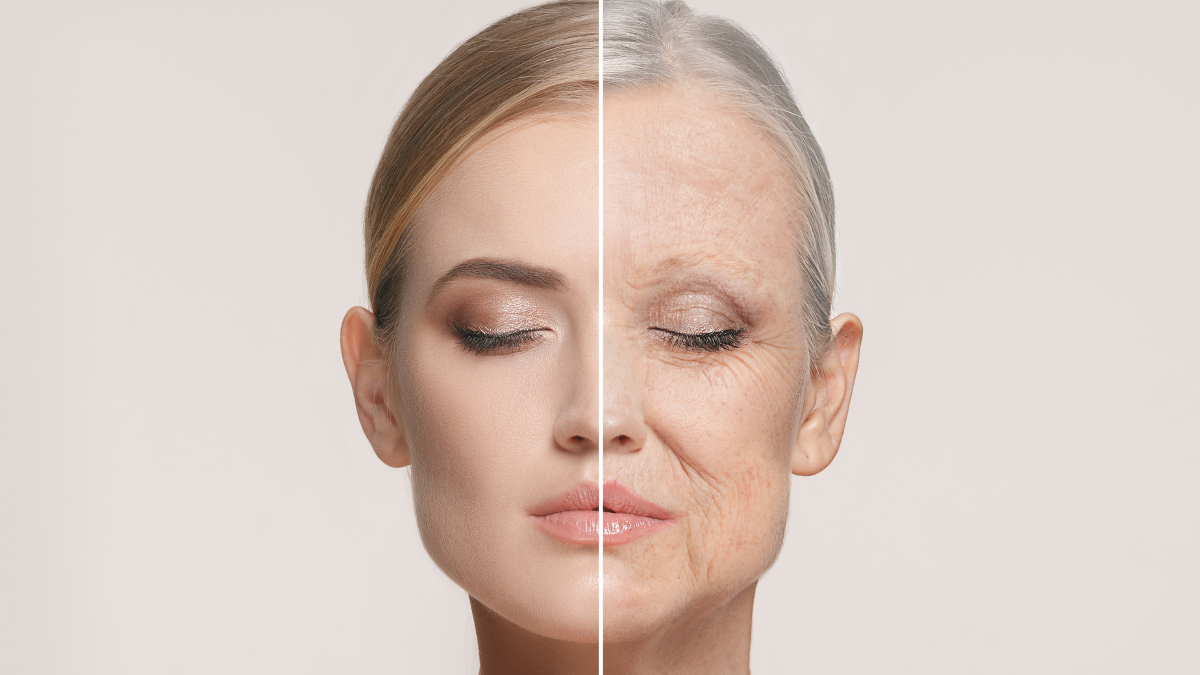Glycation: the silent process that accelerates ageing
Glycation is a silent but powerful chemical reaction that plays a key role in the aging process. Find out exactly what’s involved in this ‘spontaneous caramelisation’ of the body, and how to curb it.

What is glycation (or the Maillard reaction)?
Glycation – a simple definition
Glycation, also known as the Maillard reaction, is the binding of sugars to proteins (1). It both occurs spontaneously in the body as well as when we cook certain foods.
This chemical reaction leads to the development of glycated proteins, which accumulate inside cells and cannot be eliminated.
In a matter of days, glycated proteins are converted into compounds called Amadori products (2). After a few weeks, these end up forming Maillard products, or AGEs (Advanced Glycation End Products). Once underway, this last conversion is irreversible (3).
AGEs accelerate ageing
Maillard products are known to promote the development of various problems :
- stiffening of blood vessels;
- deterioration of tissues;
- changes to collagen which are responsible for an increase in wrinkles ;
- problematic skin healing;
- opacification of the eye’s lens;
- a sharp increase inoxidative stress(4-5)...
In short, the various stages of glycation together cause an acceleration in ageing (6-7). This process is stimulated by an overload of sugar in the body, and thus has an even more dramatic effect on diabetics (who have elevated levels of glycated haemoglobin) (8-9).
What can you do to fight glycation?
The solution lies primarily in what you eat
If you want to fight this ‘caramelisation’ of your body and slow down the effects of ageing, you need to start by looking at your diet...
Modern diets are often high in sugar and contain too much food cooked at high temperatures, both of which encourage protein glycation (10).
Which foods and cooking methods should you prioritise?
To prevent excessive glycation in your body:
- reduce your consumption of sugary desserts, especially those cooked at temperatures above 180°C (cakes, crème brulée, caramel ...) ;
- eat less ‘browned’ food (barbecued meat, roast chicken, over-baked bread...)
- avoid highly-processed products ;
- reduce your alcohol intake (especially beer and whisky...) ;
- eat more fruit and vegetables – preferably raw, dairy products (low-fat versions), fish, pulses and wholegrains;
- and choose lower temperature cooking methods, such as poaching, steaming and boiling (11).
To combat glycation, it’s also important to take regular exercise and to make sure you manage day to day stress effectively (12).
Nutrients known for their anti-glycation effects
The benefits of carnosine, aminoguanidine, Yerba mate...
In recent years, a number of studies have highlighted certain substances with the potential to help inhibit the formation of AGEs (13-14).
They include:
- carnosine, a peptide formed when the body digests protein-rich foods. This compound appears to inhibit the carbonylation and glycoxidation of proteins, and so prevent the formation of AGEs (it is available in supplement form such as in the product Carnosine). There is also a carnosine derivative called carcinine, which has a longer life in the body (Carcinine) (15-17) ;
- aminoguanidine, a compound which seems to react directly with alpha, beta-dicarbonyls (such as methylglyoxal, glyoxal and 3-deoxyglucosone) to help prevent the development of AGEs. This substance is also available as a supplement (for example Aminoguanidine) (18-20) ;
- and finally, extract of Yerba mate leaf (Ilex paraguariensis), the South-American plant used to make the energising drink ‘mate’. The high content of polyphenols (caffeic acid, chlorogenic acids …) in mate extract appears to help reduce water-retention and combat the free radicals that encourage the conversion of Amadori products into AGEs (24-25).
Further scientific research is needed in order to clarify all the mechanisms involved.
References
- Fournet M, Bonté F, Desmoulière A. Glycation Damage: A Possible Hub for Major Pathophysiological Disorders and Aging. Aging Dis. 2018;9(5):880-900. Published 2018 Oct 1. doi:10.14336/AD.2017.1121
- Shumilina J, Kusnetsova A, Tsarev A, et al. Glycation of Plant Proteins: Regulatory Roles and Interplay with Sugar Signalling?. Int J Mol Sci. 2019;20(9):2366. Published 2019 May 13. doi:10.3390/ijms20092366
- Gkogkolou P, Böhm M. Advanced glycation end products: Key players in skin aging?. Dermatoendocrinol. 2012;4(3):259-270. doi:10.4161/derm.22028
- Gill V, Kumar V, Singh K, Kumar A, Kim JJ. Advanced Glycation End Products (AGEs) May Be a Striking Link Between Modern Diet and Health. Biomolecules. 2019;9(12):888. Published 2019 Dec 17. doi:10.3390/biom9120888
- Fournet M, Bonté F, Desmoulière A. Glycation Damage: A Possible Hub for Major Pathophysiological Disorders and Aging. Aging Dis. 2018;9(5):880-900. Published 2018 Oct 1. doi:10.14336/AD.2017.1121
- Gkogkolou P, Böhm M. Advanced glycation end products: Key players in skin aging?. Dermatoendocrinol. 2012;4(3):259-270. doi:10.4161/derm.22028
- Chaudhuri J, Bains Y, Guha S, et al. The Role of Advanced Glycation End Products in Aging and Metabolic Diseases: Bridging Association and Causality. Cell Metab. 2018;28(3):337-352. doi:10.1016/j.cmet.2018.08.014
- Younus H, Anwar S. Prevention of non-enzymatic glycosylation (glycation): Implication in the treatment of diabetic complication. Int J Health Sci (Qassim). 2016;10(2):261-277.
- Uribarri J, Woodruff S, Goodman S, et al. Advanced glycation end products in foods and a practical guide to their reduction in the diet. J Am Diet Assoc. 2010;110(6):911-16.e12. doi:10.1016/j.jada.2010.03.018
- Uribarri J, Woodruff S, Goodman S, et al. Advanced glycation end products in foods and a practical guide to their reduction in the diet. J Am Diet Assoc. 2010;110(6):911-16.e12. doi:10.1016/j.jada.2010.03.018
- Kim CS, Park S, Kim J. The role of glycation in the pathogenesis of aging and its prevention through herbal products and physical exercise. J Exerc Nutrition Biochem. 2017;21(3):55-61. doi:10.20463/jenb.2017.0027
- Gill V, Kumar V, Singh K, Kumar A, Kim JJ. Advanced Glycation End Products (AGEs) May Be a Striking Link Between Modern Diet and Health. Biomolecules. 2019;9(12):888. Published 2019 Dec 17. doi:10.3390/biom9120888
- Kim CS, Park S, Kim J. The role of glycation in the pathogenesis of aging and its prevention through herbal products and physical exercise. J Exerc Nutrition Biochem. 2017;21(3):55-61. doi:10.20463/jenb.2017.0027
- Ghodsi R, Kheirouri S. Carnosine and advanced glycation end products: a systematic review. Amino Acids. 2018 Sep;50(9):1177-1186. doi: 10.1007/s00726-018-2592-9. Epub 2018 Jun 1. PMID: 29858687.
- Younus H, Anwar S. Prevention of non-enzymatic glycosylation (glycation): Implication in the treatment of diabetic complication. Int J Health Sci (Qassim). 2016;10(2):261-277.
- Babizhayev MA, Deyev AI, Savel'yeva EL, Lankin VZ, Yegorov YE. Skin beautification with oral non-hydrolized versions of carnosine and carcinine: Effective therapeutic management and cosmetic skincare solutions against oxidative glycation and free-radical production as a causal mechanism of diabetic complications and skin aging. J Dermatolog Treat. 2012 Oct;23(5):345-84. doi: 10.3109/09546634.2010.521812. Epub 2011 Jul 14. PMID: 21756141.
- He C, Sabol J, Mitsuhashi T, Vlassara H. Dietary glycotoxins: inhibition of reactive products by aminoguanidine facilitates renal clearance and reduces tissue sequestration. Diabetes. 1999 Jun;48(6):1308-15. doi: 10.2337/diabetes.48.6.1308. PMID: 10342821.
- Younus H, Anwar S. Prevention of non-enzymatic glycosylation (glycation): Implication in the treatment of diabetic complication. Int J Health Sci (Qassim). 2016;10(2):261-277.
- Thornalley PJ. Use of aminoguanidine (Pimagedine) to prevent the formation of advanced glycation endproducts. Arch Biochem Biophys. 2003 Nov 1;419(1):31-40. doi: 10.1016/j.abb.2003.08.013. PMID: 14568006.
- Ramis R, Ortega-Castro J, Caballero C, et al. How Does Pyridoxamine Inhibit the Formation of Advanced Glycation End Products? The Role of Its Primary Antioxidant Activity. Antioxidants (Basel). 2019;8(9):344. Published 2019 Sep 1. doi:10.3390/antiox8090344
- Metz TO, Alderson NL, Thorpe SR, Baynes JW. Pyridoxamine, an inhibitor of advanced glycation and lipoxidation reactions: a novel therapy for treatment of diabetic complications. Arch Biochem Biophys. 2003 Nov 1;419(1):41-9. doi: 10.1016/j.abb.2003.08.021. PMID: 14568007.
- Younus H, Anwar S. Prevention of non-enzymatic glycosylation (glycation): Implication in the treatment of diabetic complication. Int J Health Sci (Qassim). 2016;10(2):261-277.
- Lunceford N, Gugliucci A. Ilex paraguariensis extracts inhibit AGE formation more efficiently than green tea. Fitoterapia. 2005 Jul;76(5):419-27. doi: 10.1016/j.fitote.2005.03.021. PMID: 15894431.
- Bains Y, Gugliucci A. Ilex paraguariensis and its main component chlorogenic acid inhibit fructose formation of advanced glycation endproducts with amino acids at conditions compatible with those in the digestive system. Fitoterapia. 2017 Mar;117:6-10. doi: 10.1016/j.fitote.2016.12.006. Epub 2016 Dec 22. PMID: 28012919.
Keywords
2 Days
A Product worth waiting for when not…
A Product worth waiting for when not available and then arriving as a surprise!
DOMINIC
3 Days
On time shipping
On time shipping
GEORGE Verne
5 Days
Ordering was easy and the product was…
Ordering was easy and the product was delivered with no problems. Appreciated that I was notified when it would arrive. Thanks!
MascarC
11 Days
Great customer service - responsive …
I ordered from them and my item was unavailable for sometime. I was super happy when they reactivated my order and shipped my item which arrived very quickly. Great customer service.
Ruth Rueter
12 Days
Super fast shipping
Super fast shipping
Donald Borling
15 Days
Reputable companysearch and the number of…
The research and the number of selection of products.
NAKHJAVAN Shervin
28 Days
The Anti Aromatase is a great product
The Anti Aromatase is a great product. You just need to have constant inventory. Recently this product has been out of stock.
GEORGE Verne
29 Days
Great help on chat
Great help on chat. Knowledgeable and friendly.
Jason Argos
33 Days
Customer service was fast and friendly.
Customer service helped to stop the transaction process of the subscription. I appreciated that.
Greenie
33 Days
I order here due to the high quality of…
I order here due to the high quality of the products and the quick delivery of items - thank you
Barbara J
35 Days
SuperSmart's Eye Pressure supplements: highly recommended!
I purchase SuperSmart's Eye Pressure supplements regularly for over 5 years, and gotta say they are truly a wonderful product for my Glaucoma. Highly recommended if you have eye pain from your Glaucoma.
D. Martinez
39 Days
Quick service
Quick service
MONELL
40 Days
Speedy service.
Speedy service.
ROSENTHAL Marvin
43 Days
Clear website- Efficient
Clear website. Excellent search engine and fast delivery!
Mohamad Hussein
46 Days
They have great products.
They have great products.
Vickie





